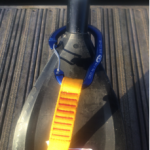
I’m sure as a SUPboarder we’ve all had to give someone a helping hand on the water at some point. Towing can be a very useful method but do you know how to do it safely and efficiently?… and without taking off your leash! A leash can be a really useful tool when towing but that’s not what it was designed for and so you shouldn’t rely on it. A leash is a necessity not an accessory.
Here the Water Skills Academy (WSA) explain some simple towing techniques that can be used by all SUPboarders, whether you’re out teaching a group or just paddling with mates…
As a SUP coach or paddling in a group, at some point we may need to resort to towing. This may happen if a paddler becomes tired, equipment failure or you feel the need to train with some extra drag?!!
Towing can be used to help or position group members as well as in a rescue situation. Some simple methods and kit that you carry can help with many situations that can arise on the water.
In the first instance we must keep things simple, as this is often the quickest, most effective solution.
Prior to any tow the best position for the client to be in is prone (lying flat). This limits the risk of further problems perhaps falling off and also keeps the client / friend equipment secure.
It is also recommended that the paddle blade be under the chest of the paddler being towed. This allows the paddle to be retained in a secure hold, while keeping both hands free, ready to help. If we are using a sling then we recommend a clean line, no loops (to get hands stuck in) or knots to get entangled.
A short tow can be practiced by simply asking a paddler to hold the back of the coach’s leash (not wrapping the leash around the wrists). This method is quick to set up, effective and simple, being particularly useful over short distances.

Using a simple sling like the ones from Palm equipment we can very effectively tow over some distance. If the paddler is able they simply hold the end of the sling or rope while the rescuer kneels on the spare end.

If the paddler is unable to hold the sling perhaps with cold hands or the client is young, we can then attach one end to the paddle. We connect under the handle with a simple clove hitch on a bight, this will, coupled with the handle stop the sling slipping off.

With the addition of a karabiner we can also now use the sling and tow in a variety of ways.
- We can simply clip into the tow point, present on most iSUPs
- By reversing the paddle (lie on handle, blade to the front) we can clip the Karabiner into the shaft.
As the rescuer we can simply kneel on the end of the sling. This allows a quick method to release the tow if required.
Being able to release the tow quickly is essential during any tow.
We may find that kneeling on the end is not effective; perhaps in choppy or windy conditions we can then use a handle on a board.
Again, we must ensure that the connecting knot is quick release; you could use a few turns or a loop on a bight.

We must ensure that throughout the tow, both paddlers are connected to the boards; leashes should not be removed to perform the tow which would leave the rescuer exposed should contact with their board be lost.
With these great techniques you’ll be a more prepared paddle. Whether you’re an instructor of a group, or out paddling with friends it’s something that all paddleboarders should know… you never know when you might need it.
Techniques like this can be learned at Water Skills Academy SUP Coach Courses and Workshop (which are open to non coaches as well). For more information visit waterskillsacademy.com or keep up to date by attending their Surf & SUP Conference in Wales on April 18th.

